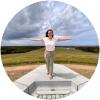I grew up in a big city, where the only birds I saw were pigeons. They’re not birds you want to watch, unless it’s to make sure they don’t steal your food. Even then, some of them look mean enough that it’s just better to let them have it.
I knew the Outer Banks would have incredible marine life, with its enviable location on the water. What I wasn’t prepared for was how much I’d learn about fowl and migratory birds. I got a small preview while driving along a quiet, one-lane road upon arrival. Out of nowhere, a red blur crossed my path. It was too small to be The Flash — it must have been a cardinal! My visit was filled with chance glimpses and encounters of our friends in the air. I heard a variety of chirps, many of them unfamiliar and varying in tone/duration. Dorothy, we were not in the city anymore.

Native Birding Tours
It wasn’t until I spent a morning with Native Birding Tours that I truly began to appreciate the richness of the destination. Our guide, Jonathan Cooley, had a master’s degree in biology and years of experience working with wildlife preservation. We met at the Bodie Island Lighthouse to start a four-hour birding tour.
We strolled the boardwalk and learned more about the conditions that give rise to such incredible bird watching in the area. I learned that North Carolina is located on the migratory route from Canada to South America, so in addition to the native birds there are many birds that pass through the region.
It is one of the best places for spotting rare species. Jonathon listed off the dozens of birds he’d spotted expertly, with ease, as I struggled to comprehend their names. I was excited I’d identified a cardinal by its bold red color; I couldn’t imagine being able to distinguish between feather design, flight patterns, and hunting habits. That’s exactly what Jonathan did. He was a walking encyclopedia, and after our brief orientation, he was taking us to the center of the action – Pea Island National Wildlife Refuge.

Pea Island Bird Watching
We drove up to the sandy bank, careful not to pull in too far in lest we get stuck. I stepped out and wondered if I should change into the dedicated sand socks I’d bought for hang gliding, but Jonathan said we wouldn’t be going very far. I made the ascent up weathered cedar steps, eagerly anticipating what lay just beyond the dunes.
It was… underwhelming. Instead of lapping waves, there were patches of still water that resembled a marsh. Instead of vibrant flowers, tall grass was the main decor. A large bug landed on me. I reacted instinctively, swatting it off with wild, exaggerated gestures and a look of sheer terror on my face. It would be the first of many to make contact that morning.
“Watch out for the biting flies,” Jonathan warned. Whatever this place was, it wasn’t making the best first impression. I put a smile on and looked around, making polite “oohs” and “ahs.” It wasn’t until I saw the world through Jonathan’s scope that my awe became genuine.
Beyond the seemingly barren landscape, there was a whole other world! There was a deer resting amidst the trees. There were dozens of different types of birds, flocking together as they’re known to do. Some were hunting, some were grooming. There was even a tundra swan who was late to head north because she was taking her sweet time soaking up the Outer Banks vibe.
One bird flew while skimming the water with an open beak to catch fish. Other birds had long, two-toned bills that they used to fetch worms out of the wet ground. We took notice of identifying marks and colors and I was able to appreciate how many differences there were in an atmosphere I’d previously perceived as bland and uninteresting. This wasn’t the loud, car horn honking cityscape I was used to – it was the nonstop, steady hum of nature I subconsciously craved.

Alligator River National Wildlife Refuge
After we spotted them all (Pokemon style!), we drove to the Alligator River National Wildlife Refuge to see what else we could add to our sighting list. Almost immediately, we saw not one but two barred owls. They were standing on the ground, digesting their recent meal. One looked younger, both looked wiser.
We also spotted an alligator and a family of turtles with bright yellow stripes. On our way through the trails, Jonathan pointed out bear paw prints on a trash can. Until then, I’d wondered why the Outer Banks kept its trash under lock and key – turns out it’s to prevent bears from helping themselves.
As we drove out of the refuge, I found myself watchful of the skies and trees, not wanting to miss any of the treasures amongst them. What I once considered to be empty, undeveloped space had been transformed into a world teeming with creatures, each their own to-do list for the day. I couldn’t believe this world had been here all along, and all it took was looking through a well positioned scope to finally see it.



